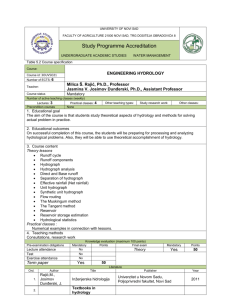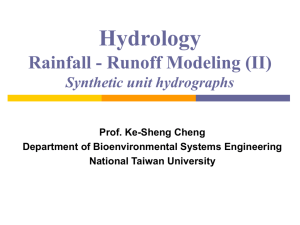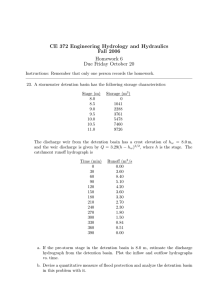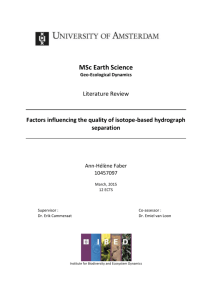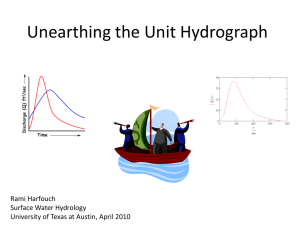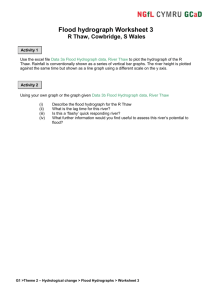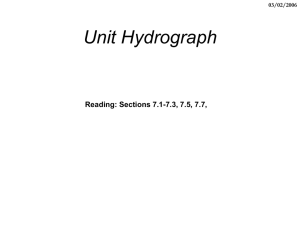Unit Hydrograph: Definition, Derivation & Application
advertisement
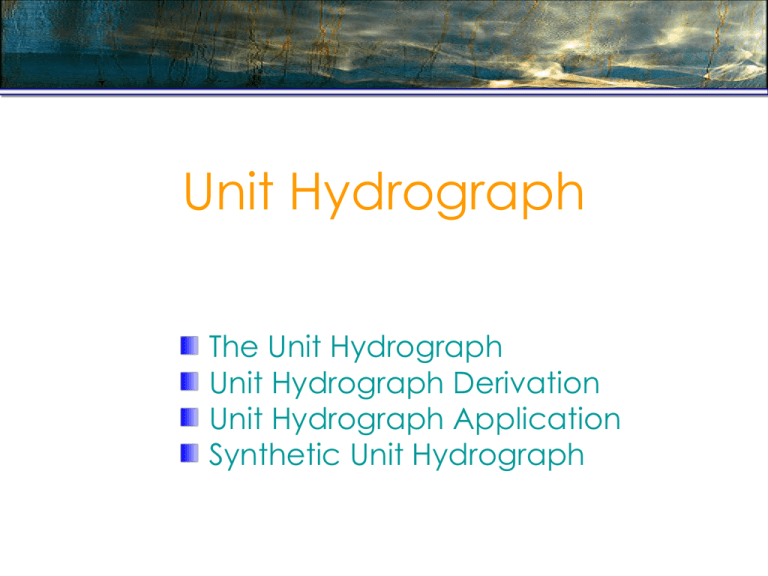
Unit Hydrograph The Unit Hydrograph Unit Hydrograph Derivation Unit Hydrograph Application Synthetic Unit Hydrograph Unit Hydrograph Definition The unit hydrograph is the unit pulse response function of a linear hydrologic system. First proposed by Sherman (1932), the unit hydrograph (originally named unit-graph) of a watershed is defined as a direct runoff hydrograph (DRH) resulting from 1 in (usually taken as 1 cm in SI units) of excess rainfall generated uniformly over the drainage area at a constant rate for an effective duration. Sherman originally used the word “unit” to denote a unit of time. But since that time it has often been interpreted as a unit depth of excess rainfall. Sherman classified runoff into surface runoff and groundwater runoff and defined the unit hydrograph for use only with surface runoff. Unit Hydrograph Assumptions The unit hydrograph is a simple linear model that can be used to derive the hydrograph resulting from any amount of excess rainfall. The following basic assumptions are inherent in this model; The excess rainfall has a constant intensity within the effective duration. The excess rainfall is uniformly distributed throughout the whole drainage area. The base time of the DRH (the duration of direct runoff) resulting from an excess rainfall of given duration is constant. The ordinates of all DRH’s of a common base time are directly proportional to the total amount of direct runoff represented by each hydrograph. For a given watershed, the hydrograph resulting from a given excess rainfall reflects the unchanging characteristics of the watershed. Unit Hydrograph Derivation Discrete Convolution Equation nM Qn PmUnm1 m1 When Qn = Direct runoff Pm = Excess rainfall Un-m+1 = Unit hydrograph Suppose that there are M pulses of excess rainfall N pulses of direct runoff in the storm considered, then N equations can be written for Qn = 1, 2, …,N in terms of N-M+1unknown values of unit hydrograph. Unit Hydrograph Derivation Discrete Convolution Equation The set of equations for discrete time convolution Q1 PU 11 Q2 P2U1 PU 1 2 Q3 P3U1 P2U2 PU 1 3 QM PMU1 PM1U2 ..... PU 1 M QM1 0 PMU2 ..... P2UM PU 1 M1 QN1 0 0 ..... 0 0 ..... PMUNM PM1UNM1 QN1 0 0 ..... 0 0 ..... 0 PM1UNM1 nM Qn PmUnm1 m1 n = 1, 2,…,N Example 1 Find the half-hour unit hydrograph using the excess rainfall hyetograph and direct runoff hydrograph given in the table. Solution. The ERH and DRH in table have M=3 and N=11 pulses respectively. Hence, the number of pulses in the unit hydrograph is NM+1=11-3+1=9. Substituting the ordinates of the ERH and DRH into the equations in table yields a set of 11 simultaneous equations. Time (1/2hr) Excess Rainfall (in) Direct Runoff (cfs) 1 1.06 428 2 1.93 1923 3 1.81 5297 4 9131 5 10625 6 7834 7 3921 8 1846 9 1402 10 830 11 313 Example 1 U1 Q1 428 404 cfs /in P1 1.06 U1 Q2 P2U1 1,928 1.93x404 1,079 cfs/in P1 1.06 U3 Q3 P3U1 P2U2 5,297 1.81x404 1.93x1,079 2,343 cfs / in P1 1.06 and similarly for the remain ordinates 9,131 1.81x1,079 1.93x2,343 2,506cfs / in 1.06 10,625 1.81x2,343 1.93x2,506 1,460 cfs / in 1.06 7,834 1.81x2,506 1.93x1,460 453 cfs / in 1.06 U4 U5 U6 Example 1 3,921 1.81x1,460 1.93x453 381cfs / in 1.06 1,846 1.81x453 1.93x381 274 cfs / in 1.06 1,402 1.81x381 1.93x274 173 cfs / in 1.06 U7 U8 U9 Unit hydrograph n Un (cfs/in) 1 404 2 3 4 5 1,079 2,343 2,506 1,460 6 7 8 9 453 381 274 173 Unit Hydrograph Application Once the unit hydrograph has been determined, it may be applied to direct runoff and streamflow hydrograph. Procedures: A rainfall hyetograph is selected. The abstractions are estimated. The excess rainfall is calculated. The time interval used in defining the excess rainfall hyetograph ordinates must be the same as that for which the unit hydrograph was specified. The discrete convolution equation may then be used to yield the direct runoff hydrograph. By adding an estimated baseflow to the direct runoff hydrograph, the streamflow hydrograph is obtained. Example 2 Calculate the streamflow hydrograph for a storm of 6 in excess rainfall, with 2 in the first half-hour, 3 in in the second half-hour and 1 in in the third half-hour. Use the half-hour unit hydrograph computed in example 1 and assume the baseflow is constant at 500 cfs throughput the flood. Check that the total depth of direct runoff is equal to the total excess precipitation. (Watershed are = 7.03 mi2) Solution. Q1 PU 1 1 2.00x404 808cfs Q2 P2U1 PU 1 2 3.00x404 2.00x1,079 1,212 2,158 3,370cfs Q3 P3U1 P2U2 PU 1 3 1.00x404 3.00x1,079 2.00x2,343 404 3,237 4,686 8,327cfs Example 2 Calculation of the direct runoff hydrograph and streamflow hydrograph Time (1/2 hr) N=1 2 3 4 5 6 7 Excess Precipitation (in) 2.00 3.00 1.00 8 9 10 11 Baseflow = 500 cfs Unit Hydrograph Ordinates (cfs/in) 1 2 3 4 5 6 7 8 9 404 1079 2343 2506 1460 453 381 274 173 808 1212 404 2158 3237 1079 4686 7029 2343 5012 7518 2506 2920 4380 1460 906 1359 453 762 1143 381 548 822 274 346 519 173 Direct Runoff (cfs) Stream flow (cfs) 808 3370 8327 13120 12781 7792 3581 2144 1549 793 173 1308 3870 8827 13620 13281 8292 4081 2644 2049 1293 673 Example 2 The total direct runoff volume is N Vd Qnt n1 54,438x0.5 cfs.h ft3 .h 3,600 s 54,438x0.5 x s 1s 9.80x107 ft3 The corresponding depth of direct runoff is found by dividing by the watershed area A=7.03 mi2=7.03x5280 ft2=1.96x108 ft2 Vd 9.80x107 rd ft 0.50 ft 6.00 in A 1.96x108 Synthetic Unit Hydrograph Unit Hydrograph: developed from rainfall and streamflow data on a watershed applies only for that watershed and for the point on the stream where the streamflow data were measured. Synthetic Unit Hydrograph: Synthetic unit hydrograph procedures are used to develop unit hydrographs for other locations on the stream in the same watershed or for nearby watersheds of a similar character. Synthetic Unit Hydrograph There are three types of synthetic unit hydrograph: Those relating hydrograph characteristics (peak flow rate, base time, etc.) to watershed characteristics. (Snyder, 1938) Those based on a dimensionless unit hydrograph. (Soil Conservation Service, 1972) Those based on models of watershed storage. (Clark, 1943) Synthetic Unit Hydrograph Snyder’s UH Snyder defined a standard unit hydrograph as one whose rainfall duration tr is related to the basin lag tp by tp 5.5tr tp = the basin lag (hr) For a standard unit hydrograph Snyder found that The basin lag is tp C1Ct LLc L = Length of the main stream from the outlet to the upstream (km) 0.3 Lc = The distance from the outlet to a point on the stream nearest the centroid of watershed area. C1 = 0.75 Ct = Coefficient derived from gaged watersheds in the same region. Synthetic Unit Hydrograph Snyder’s UH The peak discharge per unit drainage area in m3/s.km2 of the standard unit hydrograph is qp C2Cp C2 = 2.75 and Cp = Coefficient derived from gaged watersheds in the same region. tp If tpR=5.5tR tR=tr, tpR=tp, qpR=qp 0.3 ct, cp are computed from tp C1Ct LLc If tpR5.5tR t t tp tpR r R 4 tpR=tp, qpR=qp ct, cp are computed from tp C1Ct LLc 0.3 Synthetic Unit Hydrograph Snyder’s UH The relationship between qp and the peak discharge per unit drainage area qpR of the required unit hydrograph is qp C2Cp tp The base time tb in hours of the unit hydrograph can be determined using the fact that the area under the unit hydrograph is equivalent to a direct runoff of 1 cm. Assuming a triangular shape for the unit hydrograph, the base time may be estimated by tb C3 qpR C3 = 5.56 Synthetic Unit Hydrograph Snyder’s UH The width in hours of a unit hydrograph at a discharge equal to a certain percent of the peak discharge qpR is given by 1.08 W CwqpR Cw = 1.22 for the 75 percent width and 2.14 for the 50 percent width. Synthetic Unit Hydrograph Snyder’s UH Tp=5.5tr Standard UH Tp5.5tr Required UH Example 3 From the basin map of a given watershed, the following quantities are measured: L = 150 km, Lc = 75 km, and drainage area = 3,500 km2. From the unit hydrograph derived for the watershed, the following are determined: tr = 12 hr, tpR = 34 hr, and peak discharge = 157.5 m3/s.cm. Determine the coefficients Ct and Cp for the synthetic unit hydrograph of the watershed. Solution from From the given data, 5.5tR = 66 hr, which is quite different . t t t 12 tp tpR r R 34 r 4 4 ** Example 3 Solving * and ** simultaneously gives tp = 32.5 hr and tr = 5.9 hr. To calculate Ct, use tp C1Ct(LLc )0.3 32.5 0.75Ct(150 75)0.3 Ct 2.65 The peak discharge per unit area is qpR 157.5 / 3500 0.045m3 / s.km2.cm The coefficient is calculated by qp ,qpR andtp tpR qpR C2Cp 0.045 tpR 2.75Cp 34.0 Cp 0.56 Example 4 Compute the six-hour synthetic unit hydrograph of a watershed having a drainage area of 2,500 km2 with L = 100 km and Lc = 50 km. This watershed is a sub-drainage area of the watershed in example 3. Ct = 2.64 Tp 3.1L0.23S0.25I0.181.57 Qp 31.62 103 A0.96Tp1.07 0.95 TB 125.89 103 AQp 0.92 W50 16.22 103 A0.93 Qp Synthetic Unit Hydrograph SCS Dimensionless UH The SCS-UH is a synthetic unit hydrograph in which the discharge is expressed by the ratio of discharge discharge (q) to peak discharge (qp) the time the ratio of the time (t) to the time of rise of the unithydrograph (Tp) Given the peak discharge and lag time for the duration of excess rainfall, the UH can be estimated from the synthetic dimensionless hydrograph for the given basin Synthetic Unit Hydrograph SCS Dimensionless UH The figure shows a dimensionless hydrograph, prepared from the unit hydrographs of variety of watersheds. The values of qp and Tp may be estimated using a simplified model of triangular unit hydrograph. SCS suggests the time of recession may be approximated as 1.67Tp. As the area under the unit hydrograph should be equal to a direct runoff of 1 cm T = peak time, hr CA qp Tp p qp = peak discharge, cms.m c = 2.08 A = the drainage area, sq.km. Synthetic Unit Hydrograph SCS Dimensionless UH A study of unit hydrographs of many large and small rural watersheds indicates that the basin lag Tp 0.6tc Tc = time of concentration of watersheds Time to rise, Tp can be expressed in terms of lag time, tp and the duration of effective rainfall, tr t Tp r tp 2 Example 5 Construct a 10-minute SCS-UH for a basin of area 3.0 km2 and time of concentration 1.25 hr. Solution The duration tr = 10 min = 0.166 hr Lag time tp = 0.6Tc = 0.6x1.25 = 0.75 hr Rise time Tp = tr/2 + tp = 0.166/2 + 0.75 = 0.833 hr qp = 2.08x3.0/0.833 = 7.49 m3/s.cm qp CA Tp The dimensionless hydrograph in the figure may be converted to the required dimensions by multiplying the values on the horizontal axis by Tp and those on the vertical axis by qp. Alternatively, the triangular unit hydrograph can be drawn with tb = 2.67Tp = 2.22 hr. The depth of direct runoff is checked to equal 1 cm. Unit Hydrograph Different Rainfall Durations When a UH of a given express rainfall duration is available, the UH of other durations can be derived. If other durations are integral multiples of the given duration, the new UH can be easily computed by application of the principles of superposition and proportionality. However, a general method of derivation applicable to UH of any required duration may be used on the basis of the principle of superposition. This is the S-Hydrograph Method. Unit Hydrograph Different Rainfall Durations The theoretical S-Hydrograph is that resulting from continuous excess rainfall at a constant rate of 1 cm/hr for an indefinite period. This is a step response function of a watershed system The curve assume a deformed S shape and its ordinates ultimately approach the rated of excess rainfall at a time of equilibrium. This step response function, g(t) can be derived from the unit pulse response function, h(t) of the unit hydrograph. Unit Hydrograph Different Rainfall Durations The response at time t to a unit pulse of duration t beginning at time 0 is 1 h(t) g(t) g(t t) t The response at time t to a unit pulse beginning at time t is equal to h(t-t) h(t t) 1 g(t) g(t t) g(t 2t) t The response at time t to a third unit pulse beginning at time 2t is h(t 2t) 1 g(t 2t) g(t 3t) t Continuing this process indefinitely, summing the resulting equations, rearranging, yields the unit step response function g(t) t h(t) h(t t) h(t 2t) .... S-Hydrograph Unit Hydrograph Different Rainfall Durations After S-Hydrograph is constructed, the UH of a given duration can be derived as follows: S-Hydrograph Advance the position of the SHydrograph by a period equal to the desired duration t’ called as Offset S-Hydrograph g(t t) g(t) Offset S-Hydrograph The difference between the ordinates of the original SHydrograph and the Offset S Hydrograph, divided by t’ gives the desired UH h(t) Unit Hydrograph of Duration t’ 1 g(t) g(t t) t Example 6 Use the 0.5 hr unit hydrograph in example 1 to produce the Shydrograph and the 1.5 hr unit hydrograph for this watershed. Solution The 0.5 unit hydrograph is shown in column 2. The S-hydrograph is found using (with t = 0.5 hr) g(t) t h(t) h(t t) h(t 2t) .... For t = 0.5 hr : g(t) = t.h(t) = 0.5x404 = 202 cfs For t = 1.0 hr : g(t) = t.[h(t)+h(t-0.5)] = 0.5x[1,079+404] = 742 cfs For t = 1.5 hr : g(t) = t.[h(t)+h(t-0.5)+h(t-1.0)] = 0.5x[2,343+1,079+404] = 1,913 cfs Example 6 Calculation of a 1.5 hr unit hydrograph by S-hydrograph method 1 5 4 Lagged 0.5-h unit S-hydrograph Hydrograph Time 2 0.5-h Unit Hydrograph 3 S-hydrograph t h(t) g(t) g(t t) h(t) (hr) (cfs/in) (cfs) (cfs) (cfs/in) 0.5 1.0 1.5 2.0 2.5 3.0 3.5 4.0 4.5 5.0 5.5 6.0 404 1079 2343 2506 1460 453 381 274 173 0 0 0 202 742 1913 3166 3896 4123 4313 4450 4537 4537 4537 4537 0 0 0 202 742 1913 3166 3896 4123 4313 4450 4537 135 495 1275 1976 2103 1473 765 369 276 149 58 0
